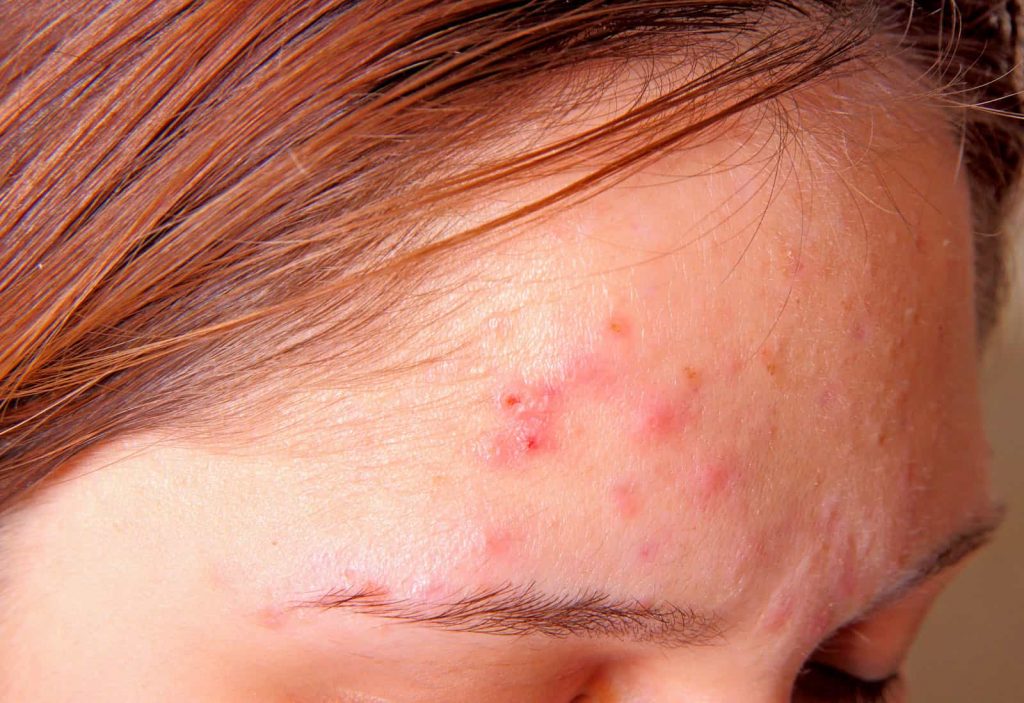
Acne is generally more rampant during adolescence but it can also be troublesome for adults. During puberty, the skin cell lining located inside the hair follicles begins to shed profoundly. The skin begins to increase oil production and the pore becomes clogged with dead skin cells, excess oil and bacteria. The pore begins to swell which causes a break in the follicle wall. When the rupture happens close to the surface of the skin, the lesion is generally small and is able to heal quickly. If the rupture occurs deep in the follicle wall, the infection spills out into the dermis and destroys healthy tissue. The body sends new collagen to repair the damaged area but the new tissue may leave the person with an acne scar because of too much collagen in the area creating a mass of raised tissue on the skin’s surface. This type of scarring is referred to as hypertrophic or keloid scarring. In general, acne scars are caused by a loss of tissue and this is called atrophic, or depressed, scars. Two types of atrophic scars are ice-pick and boxcar scars. Ice-pick scars are deep, narrow and pitted scars. Boxcar scars are broad depressions with sharply defined edges. The more inflammation in the skin, the more likely that acne scarring will occur.
A person who experiences persistent outbreaks of severe inflammatory acne can have significantly damaged tissue due to the large regions of skin impacted by the condition. The frequency of the outbreaks does not allow the skin time to adequately heal. Furthermore, the vast inflammation stops the body from assembling the normal healing process required to properly repair the skin. Consequently, people who suffer from persistent cases of inflammatory acne are at high risk for developing permanent acne scarring. Fortunately, there are many options for treating acne scarring:
- Topical medications to treat acne contain benzoyl peroxide and salicylic acid. Retin-A, Renova and Avita are some of the most popularly prescribed topical medications for acne scars.
- Soft tissue fillers can be used to fill in deep and pitted scars by injecting the material directly under the skin. Fillers are only temporary and will need to be repeated to maintain lasting results.
- Laser treatments such as ablative, non-ablative and fractional lasers use a pulse of light to penetrate the layers of skin. The damaged layers will be removed while stimulating collagen production and cell renewal.
- Dermabrasion uses a powerful handheld tool with an abrasive wheel, diamond fraise or wire brush. The tool is moved over the surface of the scars to remove the top layers of skin and alleviate the scars.
Sometimes an acne scar is not necessarily a scar at all but rather a post-inflammatory color change. Post-inflammatory changes are a temporary discoloration of the skin generally seen after acne lesions have healed. If they are pink or purple flat patches, they are referred to as post-inflammatory erythema. If they appear brown in color, they are called post-inflammatory pigmentation. White marks are called post-inflammatory hypopigmentation or PIH. It can take several months for post-inflammatory color changes to improve but they will eventually fade on their own. Some patients use azeliac acid creams or hydroquinone bleaching creams to reduce pigmentation and lessen the appearance of these scars. Superficial chemical peels which contain glycolic acid or Jessner solution can also help to improve the appearance of acne scars.
-SP
